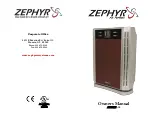
19
CARA
TTERISTICHE
•
FEA
TURES
ciente k=1,7÷(1,2)
2
=1,18 (curva 1).
Ora, a parità di circuito idraulico, le perdite di carico
aumentano al diminuire della temperatura media della por-
tata d’acqua di passaggio; nella tabella 1 si legge, passando
da una temperatura media di circa 50 °C alla temperatura di
circa 10 °C, un coefficiente moltiplicativo delle perdite pari
a 1,28. Ciò significa che la caratteristica resistente del cir-
cuito con acqua fredda, dovrà passare per il punto porta-
ta=1,2 m
3
/h e perdite di carico 1,7 x 1,28 = 2,17 m C.A. Il
coefficiente k di questa nuova parabola sarà dunque
k=2,17÷(1,2)
2
=1,51; la portata che si instaura nel funziona-
mento in raffreddamento si trova in corrispondenza al punto
di incrocio tra questa nuova parabola di coefficiente 1,51
(curva 3) e la caratteristica di prevalenza fornita dall’ID 31,
che si legge nel diagramma (curva 4). Tutte le curve di cui
sopra sono state ricostruite nel diagramma di Fig. 2; si
legge, in corrispondenza al punto di funzionamento estivo,
la portata di 1,37 m
3
/h, pari a 1.370 l/h.
Si può ora ipotizzare che la variazione di portata d' acqua
ai singoli ventilconvettori, sia proporzionale alla variazione
che interviene nella portata totale; allora, se
portata tot. invernale÷portata tot. estiva = 1.200÷1.370 = 0,88
allora anche per il singolo ventilconvettore:
portata estiva = portata invernale÷0,88.
In tabella 5 sono indicate le portate che si instaurano nel
funzionamento estivo.
Dalle tav. 9-10-11 si ricavano le rese frigorifere dei ventil-
convettori alimentati con acqua a 7 °C (vedi tab. 5); con-
frontando i valori con quanto riportato in tab. 2, risulta che
tali rese sono più che sufficienti a coprire il fabbisogno ter-
mico estivo degli ambienti. Se ciò non fosse, o addirittura si
scendesse sotto la portata minima consentita per un buon
funzionamento dei ventilconvettori, bisogna cambiare il
dimensionamento del circuito di distribuzione, oppure le
caratteristiche dei circolatori (per esempio aumentando la
velocità di rotazione per i circolatori a più velocità).
Si è così realizzato un impianto di raffrescamento estivo
molto versatile (l’utente può decidere di volta in volta,
secondo le necessità, quali ventilconvettori mantenere in
funzione), che ha il pregio di mantenere la potenza elettrica
assorbita (in questo caso, in condizioni nominali, solo
1.650 W), entro limiti che consentano di rientrare nei nor-
mali contratti di fornitura stipulati dall’ENEL per utenze di
tipo domestico.
Now, with the same hydraulic circuit, the pressure drops
increase with the decreasing of the average water flow tem-
perature. Table 1 gives a multiplication factor on the pressu-
re drops of 1.28, when passing from an average temperature
of about 50°C to a temperature of about 10°C. This means
that the resistance pattern of the circuit with cold water
should pass through the point, flow=1.2 m
3
/h and pressure
drop = 1.7
x
1.28 = 2.17 m W.G.. Coefficient k of this new
parabola will thus be k=2.17÷(1.2)
2
=1.51. The flow attained
in cooling is found at the intersect point between this new
parabola of coefficient 1.51 (curve 3) and the available
head pattern given by the ID 31, which can be obtained
from the chart (curve 4). All the above curves have been
reconstructed in the chart at Fig. 2. In correspondence to
the summer operation point, a flow of 1.37 m
3
/h, or 1.370
l/h is given.
Now let us presume that the variation in water flow of the
single fancoils, is proportional to the variation of the total
flow. So, if
tot. winter flow ÷ tot. summer flow = 1.200÷1.370 =0.88
then also for the fancoil:
summer flow=winter flow ÷ 0.88.
Table 5 gives the flows attained in summer operation.
From tab. 9-10-11 the cooling capacities of the fancoils can
be obtained, supplied with water at 7°C (see tab. 5).
Comparing the values with tab. 2, shows that these capaci-
ties are amply sufficient to cover the summer thermal need
of the rooms. If this were not the case, or at worst they drop-
ped under the minimum flow permitted for the correct ope-
ration of the fancoils, you would have to change the distri-
bution circuit sizing, or the pump characteristics (e.g.
increasing the delivery speed for pumps with variable
speeds).
So a very versatile summer cooling plant has been created
(the user can decide, according to his/her needs, which fan-
coils to run when and where), which has the advantage of
maintaining the absorbed electric power (in this case, at
nominal conditions, only 1.650 W), within the limits that
allow to fall in the normal supply contracts made by the
Electricity Board per domestic plants.
Tab. 4
Dimensionamento invernale
FCX
NV
VF
PM
PA
RT
Winter sizing
(l/h)
(l/h)
(W)
bagno •
bathroom
16
1
med.
150
200
1.160
camera dei bambini •
child’s bedroom
21
1
min.
200
250
1.350
camera matrimoniale •
parent’s bedroom
31
1
min.
200
250
2.000
cucina-soggiorno •
kitchen-living room
31
2
med.
200
250
2
x
2.730
Tab. 5
Dimensionamento estivo
FCX
NV
VF
PR
RF
Summer sizing
(l/h)
(W)
bagno •
bathroom
16
1
med.
227
980
camera bambini •
child’s bedroom
21
1
min.
284
1.235
camera matrimoniale •
parent’s bedroom
31
1
min.
284
1.750
cucina-soggiorno •
kitchen-living room
31
2
med.
284
2
x
2.025
NV = Numero di ventilconvettori
Number of fancoils
PA = Portata d’acqua proposta
Proposed water flow
PM = Portata minima ricavata dai diagrammi
Minimum flow obtained from charts
PR = Portata d’acqua risultante
Final water flow
RF = Resa frigorifera corrispondente
Corresponding cooling capacity
RT = Resa termica in condizioni di progetto
Heating capacity at design conditions
VF = Velocità di funzionamento di progetto
Design operating speed
Summary of Contents for IDROSPLIT
Page 2: ......
Page 4: ......
Page 37: ...37 INSTALLAZIONE INSTALLATION A B B C C C Fig 8 Fig 9 Fig 10 Fig 12 Fig 11 ...
Page 46: ......
Page 47: ......
















































